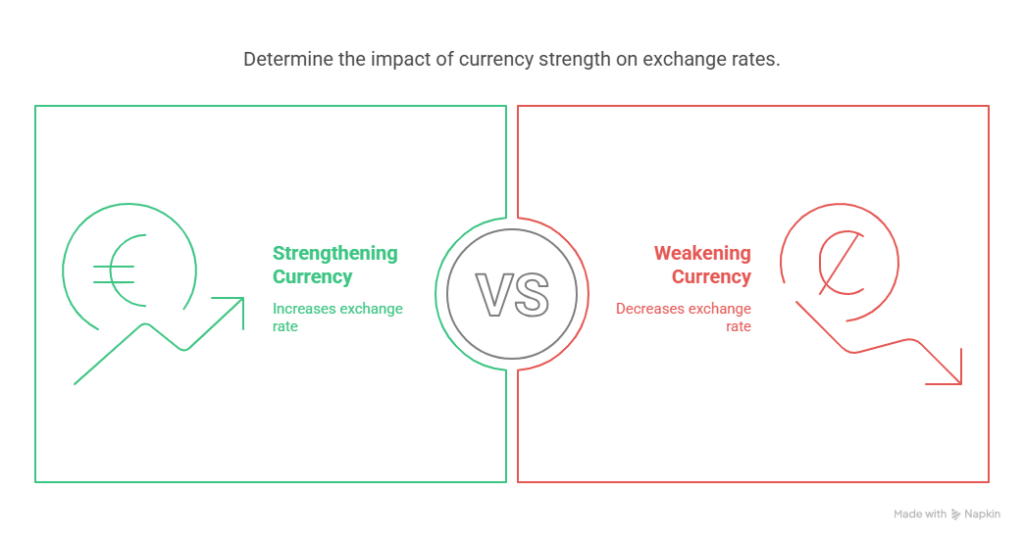Forex trading starts with one fundamental concept: the currency pair. If you’ve ever stared at something like EUR/USD = 1.20 and wondered what it really means, you’re not alone.
Understanding how currency pairs work — especially the difference between the base currency and the quote currency — is essential for making informed trading decisions. This isn’t just theory; it’s the foundation on which every single forex trade is built.
In this lesson, we’ll break down these key terms and show you how exchange rates are constructed, interpreted, and traded.
What Is a Currency Pair?
A currency pair represents the value of one currency relative to another. Think of it as a tug-of-war between two economies, expressed numerically.
Let’s take EUR/USD = 1.20 as an example:
- EUR (euro) is the base currency.
- USD (US dollar) is the quote currency.
This simply means 1 euro is equal to 1.20 US dollars. If you’re buying EUR/USD, you’re effectively buying euros and selling dollars at that quoted exchange rate.
Currency pairs always follow this format:
Base/Quote = Exchange Rate
The Base Currency: Your Trading Anchor
The base currency is the first currency listed in a pair. It acts as the “benchmark” currency against which the second currency is measured.
When you see USD/JPY = 110, that means:
- USD is the base.
- You’re buying 1 US dollar for 110 Japanese yen.
Note:
- When you buy a currency pair, you’re buying the base and selling the quote.
- When you sell a currency pair, you’re selling the base and buying the quote.
In essence, the base currency is what you’re speculating will rise or fall in value against the quote currency.
The Quote Currency: The Comparator
The quote currency, also known as the counter currency, is the second currency in a pair. It tells you how much of it is needed to buy one unit of the base currency.
For example:
- In GBP/AUD = 1.80, it means 1 British pound equals 1.80 Australian dollars.
The quote currency acts like a “price tag” — it shows how much you need to pay in one currency to own a unit of the other.
Understanding this is critical because your profits and losses are calculated in the quote currency. If you’re trading GBP/AUD and the rate moves from 1.80 to 1.90, the pound has strengthened, and you would profit if you were long on the pair.
How Exchange Rates Work
Exchange rates show the relative strength between two currencies. They constantly fluctuate due to economic, political, and market factors.
Let’s break this down with an example:
- USD/CHF = 1.00 means 1 US dollar equals 1 Swiss franc.
- If it changes to 1.20, the US dollar has strengthened — now it takes more francs to buy one dollar.
Rule of Thumb:
- If the base currency strengthens, the exchange rate goes up.
- If the base currency weakens, the exchange rate goes down.
These fluctuations are what traders capitalize on in the forex market.

Types of Currency Pairs
Currency pairs aren’t all created equal. They’re grouped into three categories based on liquidity, volume, and market interest:
1. Major Pairs
These include the most traded currencies in the world and always involve the US dollar. Examples:
- EUR/USD
- USD/JPY
- GBP/USD
2. Minor Pairs
These exclude the US dollar but involve other major currencies. Examples:
- EUR/GBP
- AUD/NZD
- GBP/CHF
3. Exotic Pairs
These involve a major currency paired with a less liquid or emerging market currency. Examples:
- USD/TRY (Turkish Lira)
- EUR/ZAR (South African Rand)
Quick Comparison Table:
| Type | Includes USD? | Liquidity | Example |
|---|---|---|---|
| Major | Yes | High | EUR/USD |
| Minor | No | Medium | EUR/GBP |
| Exotic | Sometimes | Low | USD/TRY |
Why It Matters for Traders
Understanding base and quote currencies helps you:
- Properly interpret exchange rates.
- Accurately size your positions.
- Develop trading strategies based on expected currency strength or weakness.
Let’s say you expect the euro to strengthen against the US dollar. You’d go long EUR/USD — buying euros and selling dollars. But if you think the US dollar will gain strength, you’d short EUR/USD instead.
Having clarity on how currency pairs work ensures you’re not just pressing buttons — you’re executing trades based on informed analysis.
Recap & Takeaway
Here’s what you should now understand:
- The base currency is what you’re buying or selling.
- The quote currency shows how much you’re paying to do it.
- Exchange rates reflect the strength of one currency relative to another.
- Different pair types (major, minor, exotic) offer different risk/reward profiles.
Mastering the dynamics of base and quote currencies is the first step to trading with confidence and clarity. As you dive deeper into fundamental and technical analysis, this foundational knowledge will pay dividends — literally and figuratively.
📚 Sources
- Investopedia – Base Currency: Definition and Examples
- Fixer.io – Base Currency and Quote Currency Guide
- ForexTime – What Are Base and Quote Currencies?
- Investopedia – Currency Pair Overview
- Corporate Finance Institute – Currency Pair Basics
- Investopedia – Quote Currency